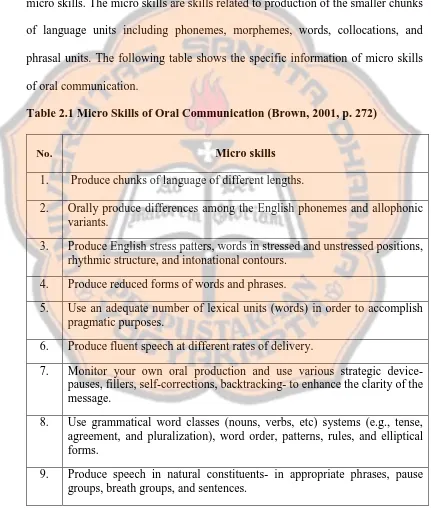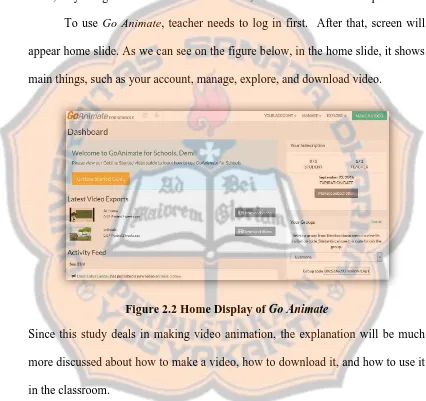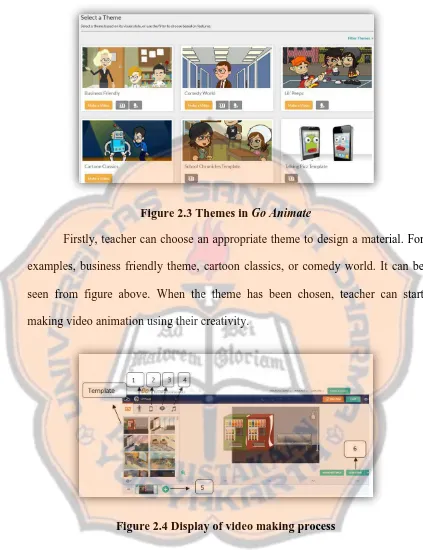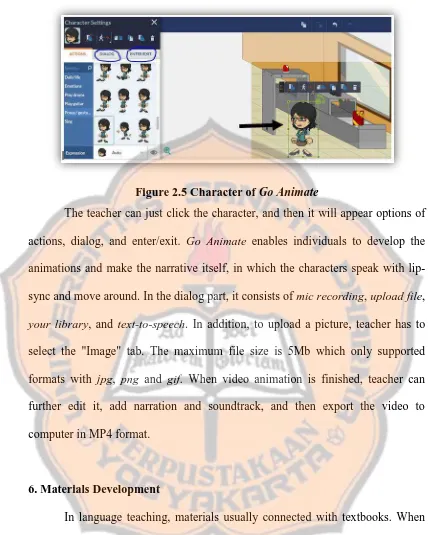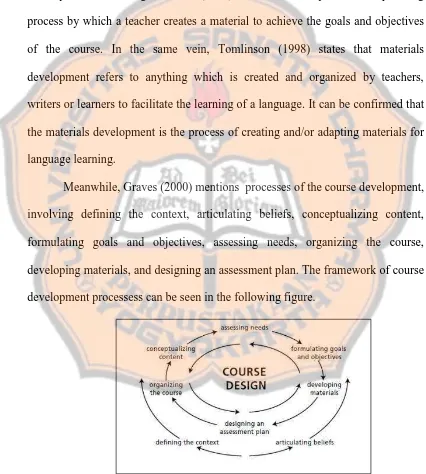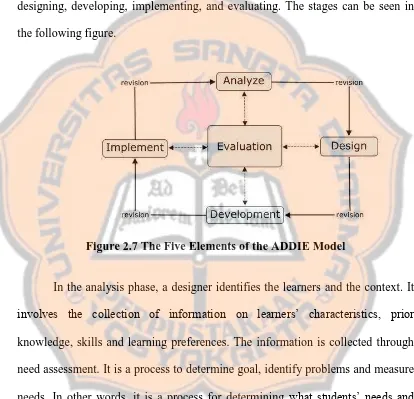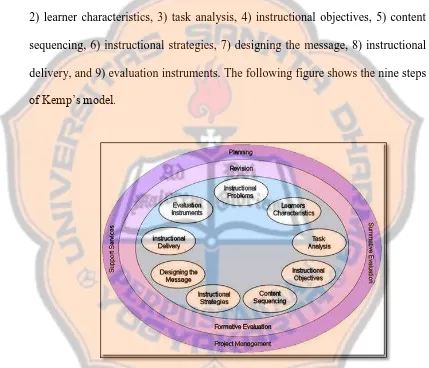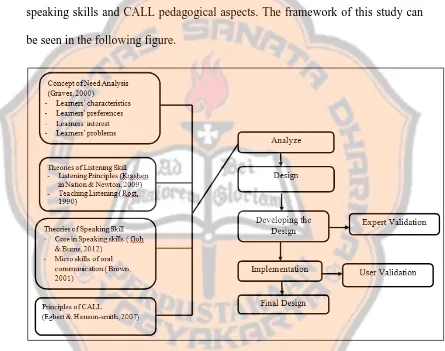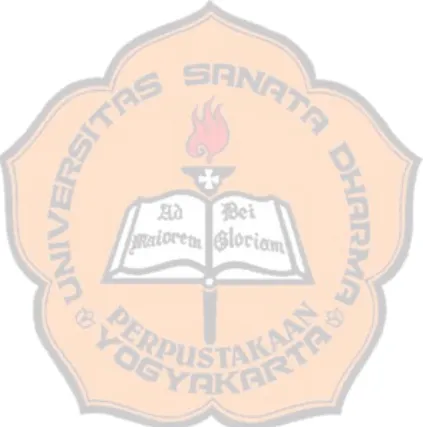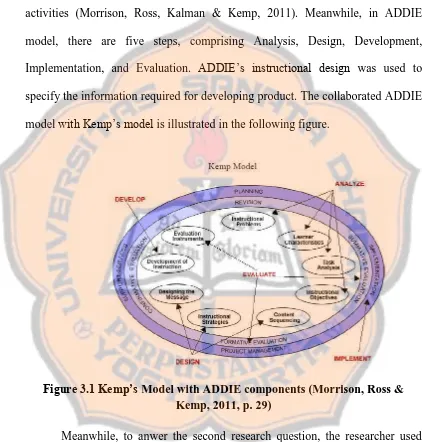xv ABSTRACT
Demi Lidya Landau. 2016. Multimedia-Based Materials to Develop Fifth Grade Elementary School Students’ English Oracy. Yogyakarta: The Graduate Program in English Language Studies, Sanata Dharma University.
Fifth grade Elemetary School students are categorized as young learners. In understanding new language specifically foreign language, surely it is still difficult for them since their speaking equipment has not yet developed perfectly. Even to understand their mother tongue, they are still struggling on it. Multimedia which present input enhanced by pictures, graphics, animation, video, and sound are considered will help the students a lot in learning the language since they can see while listening. In this study, the video animation was used. By using video, the students can do playback to hear specific parts of a segment they need. Therefore, this study formulated two research questions: (1) What do suitable video animation-based materials for oracy in Elementary School look like? (2) Which CALL pedagogical aspects are dominant in the video animation-based materials learning model?
In answering the two research questions, ADDIE model and Kemp’s
model were employed which consist Analysis, Design, Development, Implementation and Evaluation. The data were obtained through questionnaires and interview. To validate the product, two English lecturers and two English teachers evaluated it. After the materials had been revised, the product was implemented to fifth grade elementary school students as the participants. Then, at the end of the last meeting, the students were given questionnaire to obtain their opinions, suggestions, and comments about the designed materials. Lastly, with their feedback, the designed materials were revised and developed.
The final products are a students’ book, a teacher’s manual and a PowerPoint presentation. The students’ book presents materials that could be used by the students themselves. The video animation is utilized in certain section of the unit. Meanwhile, the teacher’s manual contains the procedures on how to use the video animation-based materials. Then, the PowerPoint presentation provides links to the video animation so that the users do not need to open any other files or folders for which videos will be viewed. Moreover, the PowerPoint presentation aimed to avoid confusion about which video should be played. Furthermore, to answer the second research question, a questionnaire was employed as the instrument. From the result, all of the eight pedagogical aspects were dominant in the designed materials which mean that the designed materials were categorized as good materials. The materials enable the students to work in an atmosphere with an ideal stress/anxiety level (4.53 in a scale of 1- 5), to interact in the target language with an authentic audience (4.35), to attend mindfully to the learning process (4.26), to have adequate time and feedback (4.15), to learn autonomously (3.95), to get involved in authentic tasks (3.9), to interact and negotiate meaning (3.83), and to produce varied and creative language (3.8).
xvi
ABSTRAK
Demi Lidya Landau. 2016. Multimedia-Based Materials to Develop Fifth Grade Elementary School Students’ English Oracy. Yogyakarta: Program Pasca Sarjana Universitas Sanata Dharma.
Siswa kelas 5 Sekolah Dasar dikategorikan sebagai pelajar yang masih anak-anak. Dalam memahami bahasa baru khususnya bahasa asing, mereka masih mengalami kesulitan karena pembendaharaan kata serta cara mereka berbicara belum begitu berkembang sempurna. Bahkan untuk memahami bahasa ibu pun, mereka masih berjuang. Multimedia yang menyajikan input yang ditingkatkan dengan gambar, grafik, animasi, video, dan suara dianggap akan banyak membantu siswa dalam belajar bahasa Inggris karena mereka dapat melihat saat mendengarkan. Dalam penelitian ini, video animasi digunakan. Dengan menggunakan video, siswa dapat memutar ulang untuk mendengarkan bagian-bagian segmen tertentu yang mereka butuhkan. Oleh karena itu, penelitian ini merumuskan dua pertanyaan penelitian: (1) Bagaimana desain dari materi berbasis video animasi untuk pembelajaran oracy di Sekolah Dasar yang sesuai? (2) Aspek pedagogik mana saja yang dominan dalam materi berbasis video animasi?
Dalam menjawab dua pertanyaan penelitian, Model ADDIE dan model Kemp digunakan yang terdiri dari Analisis, Perancangan, Pengembangan, Implementasi dan Evaluasi. Data diperoleh melalui kuesioner dan wawancara. Untuk memvalidasi produk, dua dosen bahasa Inggris dan dua guru bahasa Inggris yang mengevaluasi. Setelah telah direvisi, produk diterapkan pada siswa kelas lima Sekolah Dasar yang sebagai peserta. Kemudian, pada akhir pertemuan, para siswa diberi kuesioner untuk mendapatkan pendapat, saran, dan komentar mereka mengenai bahan yang telah dirancang. Terakhir, dengan umpan balik mereka, produk direvisi dan dikembangkan.
Produk akhir menghasilkan buku siswa, buku panduan untuk guru dan PowerPoint Presentation. Buku siswa menyajikan materi yang dapat digunakan oleh siswa sendiri. Video animasi digunakan pada bagian tertentu di setiap unitnya. Sementara itu, buku panduan untuk guru berisikan prosedur tentang cara menggunakan materi berbasis video animasi. Kemudian, PowerPoint Presentation menyediakan link ke video animasi yang akan di putar, sehingga pengguna tidak perlu membuka file lain atau folder yang video akan dilihat. Selanjutnya, untuk menjawab pertanyaan penelitian kedua apakah dalam materi berbasis video animasi kedelapan aspek pedagogik dominan. Untuk mendapatkan informasi ini, kuesioner digunakan sebagai instrumen. Dari hasil penelitian, delapan aspek pedagogik tersebut dapat ditemukan di desain model pembelajaran. Materi yang telah didesain dapat membuat siswa bekerja dalam suasana dengan tingkat stres / kecemasan ideal (4,53 dalam skala 1- 5), berinteraksi dengan audiens yang otentik menggunakan bahasa Inggris (4.35), mengikuti proses pembelajaran secara sadar ( 4,26), memiliki cukup waktu dan umpan balik (4,15), belajar secara mandiri (3,95), terlibat dalam tugas-tugas otentik (3,9), berinteraksi dan bernegosiasi makna (3.83), dan menghasilkan bahasa yang bervariasi dan kreatif (3.8).
MULTIMEDIA-BASED MATERIALS TO DEVELOP FIFTH
GRADE ELEMENTARY SCHOOL
STUDENTS’ ENGLISH
ORACY
A THESIS
The Graduate Program in English Language Studies in a Partial Fulfillment of the Requirements
for the Degree of
Magister Humaniora (M. Hum.) in
English Language Studies
by
Demi Lidya Landau Student Number: 146332013
THE GRADUATE PROGRAM IN ENGLISH LANGUAGE STUDIES SANATA DHARMA UNIVERSITY
i
MULTIMEDIA-BASED MATERIALS TO DEVELOP FIFTH
GRADE ELEMENTARY SCHOOL
STUDENTS’ ENGLISH
ORACY
A THESIS
The Graduate Program in English Language Studies in a Partial Fulfillment of the Requirements
for the Degree of
Magister Humaniora (M. Hum.) in
English Language Studies
by
Demi Lidya Landau Student Number: 146332013
THE GRADUATE PROGRAM IN ENGLISH LANGUAGE STUDIES SANATA DHARMA UNIVERSITY
vi
“Be not afraid of greatness. Some are born great,
some
achieve
greatness,
and
others
have
greatness thrust upon them”
-William Shakespeare-
I dedicate this thesis to Allah SWT, all teachers and academicians,
to my beloved parents, sister, brothers and family, and to all my best
vii
ACKNOWLEDGEMENTS
I am so grateful to Allah al-Mighty, the Most Merciful, for the countless blessings, for the strength and patience so I can accomplish this work. I would like also to express my sincerest thanks to the person who stood on the frontline for me,
my thesis advisor, Dr. B.B. Dwijatmoko, M.A. His patience, encouragement, and
guidance from the initial to the final level in accomplishing my thesis are much
appreciated. My sincere appreciation also goes to F.X. Mukarto, Ph.D. and Dr. J. Bismoko., for their valuable inputs and suggestions during the thesis review and the thesis defense. Many thanks are also directed to Dr. E. Sunarto, M. Hum., for giving me very useful feedback during the thesis defense. Besides, I am thankful to my lecturers, Dra. Novita Dewi, M.S., M.A. (Hons), Ph.D. and Romo Patrisius Andalas, S.J., S.S., S.T.D. for sharing their invaluable knowledge with me.
I am also deeply indebted to my lecturers, Widya Kiswara, S.Pd., M. Hum.,
and Josephine Sri Murwani Pudji Lestari, M.Hum., for their credible inputs and
suggestions in evaluating my design. Besides, I would also like to thank to Maria
Narnere, S.Pd. and April, S.Pd, for the useful feedback so that I can develop my
design. Thanks to Drs. Mujiyana, the headmaster of SD Negeri Purwomartani
Kalasan, Yogyakarta for permitting and supporting me to conduct my research in the
school. I also thank the fifth grade students of SD Negeri Purwomartani Kalasan for
their cooperation.
viii
ix
TABLE OF CONTENTS
TITLE PAGE...i
APPROVAL PAGE...ii
DEFENSE APPROVAL PAGE...iii
STATEMENT OF WORK ORIGINALITY ... iv
LEMBAR PERNYATAAN PERSETUJUAN PUBLIKASI... v
ACKNOWLEDGEMENTS ... vii
TABLE OF CONTENTS ... ix
LIST OF TABLES ... xii
LIST OF FIGURES ... xiii
LIST OF APPENDICES ... xiv
ABSTRACT ... xv
ABSTRAK ... xvi
CHAPTER I INTRODUCTION ... 1
A. Background of the Study ... 1
B. Problem Limitation ... 6
C. Research Questions ... 6
D. Research Objectives ... 6
E. Research Benefits ... 8
CHAPTER II LITERATURE REVIEW ... 9
A. Theoretical Review ... 9
1. Oracy ... 9
a. Listening Skills ... 10
b. Speaking Skills ... 16
2. Elementary School Students ... 23
a. Characteristics of Elementary School Students ... 24
b. Curriculum in Elementary School ... 24
c. Teaching English Oracy in Elementary School Students ... 25
3. Computer Assisted Language Learning (CALL) ... 27
x
5. Video Animations ... 32
a. Th Nature of Video Animation ... 32
b. Go Animate Video Animation Features ... 33
6. Materials Development ... 35
7. Instructional Design Model ... 41
8. Review of Related Studies ... 45
B. Theoretical Framework ... 48
CHAPTER IIIMETHODOLOGY ... 51
A. Research Method ... 51
B. Research Procedure ... 53
1. Analysis ... 53
2. Design ... 57
3. Development ... 58
4. Implementation ... 64
5. Evaluation ... 64
6. Product Revision ... 67
CHAPTER IV RESULTS AND DISCUSSION ... 68
A. Results of Designing the Video Animation-based Materials ... 68
1. Needs ... 68
a. Syllabus Analysis ... 69
b. Students’ Questionnaire ... 70
c. Teacher’s Interview ... 79
2. Design ... 80
3. Development ... 84
a. Developing the Video Animation-based Materials ... 94
b. Expert Validation ... 89
4. Implementation ... 97
5. User Validation ... 99
6. The Final Version of the Designed Materials ... 102
xi
CHAPTER V CONCLUSIONS AND SUGGESTIONS ... 114
A. Conclusions ... 114
B. Implications ... 117
C. Suggestions ... 118
BIBLIOGRAPHY ... 120
xii
LIST OF TABLES
Table 2.1 Micro Skills of Oral Communication... 21
Table 3.1 Need Analysis Questionnaire Blueprint ... 55
Table 3.2 How the Needs Anlysis Data are Presented ... 57
Table 3.3 The Description of the Experts ... 59
Table 3.4 Experts Validation Questionnaire Blueprint ... 59
Table 3.5 Quantitative Data Conversion ... 62
Table 3.6 How the Quantitative Data from the Expert and User Validation are Presented... ... 63
Table 3.7 User Validation Questionnaire Blueprint ... 65
Table 4.1 The Competency Standards and the Basic Competencies of Listening and Speaking Skills Grade V at Elementary School ... 69
Table 4.2 The students’ Characteristics ... 70
Table 4.3 Students’ Experiences in Using Computer and LCD Projector ... 71
Table 4.4 Students’ Preferences and Interests... 72
Table 4.5 Students’ Problems in Listening and Speaking Skills ... 74
Table 4.6 The Students’ Needs in Listening and Speaking Skills ... 75
Table 4.7 The Language Focus, Activities, and Objectives ... 81
Table 4.8 Meaning of Point of Agreement... 89
Table 4.9 Quantitative Data Conversion ... 89
Table 4.10 Result of Expert Validation Questionnaire ... 90
Table 4.11 Suggested Revisions of Open-Ended Questions of Expert Validation Questionnaire ... 93
Table 4.12 The Result of the User Validation Questionnaire ... 99
xiii
LIST OF FIGURES
Figure 2.1 The Model of Oracy and Literacy ... 9
Figure 2.2 Home Display of Go Animate ... 33
Figure 2.3 Themes in Go Animate ... 34
Figure 2.4 Display of Video Making Process ... 34
Figure 2.5 Character of Go Animate ... 35
Figure 2.6 A Framework of Course Development Processes ... 36
Figure 2.7 The Five Elements of the ADDIE Model ... 42
Figure 2.8 Kemp’s ID Model ... 45
Figure 2.9 The Conceptual Framework of Developing Instructional Materials Design ... 49
Figure 3.1 Kemp’s Model with ADDIE Components ... 52
Figure 3.2 The Mean Criteria Formulation ... 62
Figure 4.1 The Template of the Units ... 84
Figure 4.2 Opening Section in the Video Animation ... 86
Figure 4.3 Closing Section in the Video Animation ... 87
Figure 4.4 Materials Presented in the PowerPoint Presentation ... 87
Figure 4.5 Maximum File Size ... 94
Figure 4.6 An Example of Teacher’s Instruction in Practice Section ... 95
Figure 4.7 Practice Activity ... 96
Figure 4.8 An Example of Activity in the Presentation Phase ... 103
Figure 4.9 An Example of Activity in the Production Phase ... 104
Figure 4.10 An Example of Activity in the Practice Phase ... 104
xiv
LIST OF APPENDICES
Appendix 1 Syllabus of Elementary School Grade V ... 125
Appendix 2 Need Analysis Questionnaire ... 134
Appendix 3 Need Analysis Interview ... 140
Appendix 4 Expert Validation Questionnaire ... 141
Appendix 5 User Validation Questionnaire ... 144
Appendix 6 Result of Need Analysis Questionnaire... 147
Appendix 7 Descriptive Statistics of Need Analysis Questionnaire Result ... 150
Appendix 8 Result of Needs Analysis Questionnaire (Converted Score) ... 151
Appendix 9 Interview Transcription of Need Analysis ... 154
Appendix 10 Result of Experts Validation Questionnaire ... 156
Appendix 11 Result of Experts Validation Questionnaire (Converted score) .... 158
Appendix 12 Result of Open-ended Questions of Expert Validation Questionnaire ... 160
Appendix 13 Result of User Validation Questionnaire ... 162
Appendix 14 Result of User Validation Questionnaire (Converted score) ... 166
Appendix 15 Result of Open-ended Questions of User Validation Questionnaire. ... 168
Appendix 16 Surat Ijin Penelitian dari Bappeda Sleman ... 170
Appendix 17 Surat Keterangan telah Melaksanakan Penelitian ... 171
Appendix 18 Teacher’s Manual ... 172
Appendix 19 Students’ Book ... 251
xv ABSTRACT
Demi Lidya Landau. 2016. Multimedia-Based Materials to Develop Fifth Grade
Elementary School Students’ English Oracy. Yogyakarta: The Graduate Program in English Language Studies, Sanata Dharma University.
Fifth grade Elemetary School students are categorized as young learners. In understanding new language specifically foreign language, surely it is still difficult for them since their speaking equipment has not yet developed perfectly. Even to understand their mother tongue, they are still struggling on it. Multimedia which present input enhanced by pictures, graphics, animation, video, and sound are considered will help the students a lot in learning the language since they can see while listening. In this study, the video animation was used. By using video, the students can do playback to hear specific parts of a segment they need. Therefore, this study formulated two research questions: (1) What do suitable video animation-based materials for oracy in Elementary School look like? (2) Which CALL pedagogical aspects are dominant in the video animation-based materials learning model?
In answering the two research questions, ADDIE model and Kemp’s
model were employed which consist Analysis, Design, Development, Implementation and Evaluation. The data were obtained through questionnaires and interview. To validate the product, two English lecturers and two English teachers evaluated it. After the materials had been revised, the product was implemented to fifth grade elementary school students as the participants. Then, at the end of the last meeting, the students were given questionnaire to obtain their opinions, suggestions, and comments about the designed materials. Lastly, with their feedback, the designed materials were revised and developed.
The final products are a students’ book, a teacher’s manual and a PowerPoint presentation. The students’ book presents materials that could be used by the students themselves. The video animation is utilized in certain section of the unit. Meanwhile, the teacher’s manual contains the procedures on how to use the video animation-based materials. Then, the PowerPoint presentation provides links to the video animation so that the users do not need to open any other files or folders for which videos will be viewed. Moreover, the PowerPoint presentation aimed to avoid confusion about which video should be played. Furthermore, to answer the second research question, a questionnaire was employed as the instrument. From the result, all of the eight pedagogical aspects were dominant in the designed materials which mean that the designed materials were categorized as good materials. The materials enable the students to work in an atmosphere with an ideal stress/anxiety level (4.53 in a scale of 1- 5), to interact in the target language with an authentic audience (4.35), to attend mindfully to the learning process (4.26), to have adequate time and feedback (4.15), to learn autonomously (3.95), to get involved in authentic tasks (3.9), to interact and negotiate meaning (3.83), and to produce varied and creative language (3.8).
xvi
ABSTRAK
Demi Lidya Landau. 2016. Multimedia-Based Materials to Develop Fifth Grade
Elementary School Students’ English Oracy. Yogyakarta: Program Pasca Sarjana Universitas Sanata Dharma.
Siswa kelas 5 Sekolah Dasar dikategorikan sebagai pelajar yang masih anak-anak. Dalam memahami bahasa baru khususnya bahasa asing, mereka masih mengalami kesulitan karena pembendaharaan kata serta cara mereka berbicara belum begitu berkembang sempurna. Bahkan untuk memahami bahasa ibu pun, mereka masih berjuang. Multimedia yang menyajikan input yang ditingkatkan dengan gambar, grafik, animasi, video, dan suara dianggap akan banyak membantu siswa dalam belajar bahasa Inggris karena mereka dapat melihat saat mendengarkan. Dalam penelitian ini, video animasi digunakan. Dengan menggunakan video, siswa dapat memutar ulang untuk mendengarkan bagian-bagian segmen tertentu yang mereka butuhkan. Oleh karena itu, penelitian ini merumuskan dua pertanyaan penelitian: (1) Bagaimana desain dari materi berbasis video animasi untuk pembelajaran oracy di Sekolah Dasar yang sesuai? (2) Aspek pedagogik mana saja yang dominan dalam materi berbasis video animasi?
Dalam menjawab dua pertanyaan penelitian, Model ADDIE dan model Kemp digunakan yang terdiri dari Analisis, Perancangan, Pengembangan, Implementasi dan Evaluasi. Data diperoleh melalui kuesioner dan wawancara. Untuk memvalidasi produk, dua dosen bahasa Inggris dan dua guru bahasa Inggris yang mengevaluasi. Setelah telah direvisi, produk diterapkan pada siswa kelas lima Sekolah Dasar yang sebagai peserta. Kemudian, pada akhir pertemuan, para siswa diberi kuesioner untuk mendapatkan pendapat, saran, dan komentar mereka mengenai bahan yang telah dirancang. Terakhir, dengan umpan balik mereka, produk direvisi dan dikembangkan.
Produk akhir menghasilkan buku siswa, buku panduan untuk guru dan PowerPoint Presentation. Buku siswa menyajikan materi yang dapat digunakan oleh siswa sendiri. Video animasi digunakan pada bagian tertentu di setiap unitnya. Sementara itu, buku panduan untuk guru berisikan prosedur tentang cara menggunakan materi berbasis video animasi. Kemudian, PowerPoint Presentation menyediakan link ke video animasi yang akan di putar, sehingga pengguna tidak perlu membuka file lain atau folder yang video akan dilihat. Selanjutnya, untuk menjawab pertanyaan penelitian kedua apakah dalam materi berbasis video animasi kedelapan aspek pedagogik dominan. Untuk mendapatkan informasi ini, kuesioner digunakan sebagai instrumen. Dari hasil penelitian, delapan aspek pedagogik tersebut dapat ditemukan di desain model pembelajaran. Materi yang telah didesain dapat membuat siswa bekerja dalam suasana dengan tingkat stres / kecemasan ideal (4,53 dalam skala 1- 5), berinteraksi dengan audiens yang otentik menggunakan bahasa Inggris (4.35), mengikuti proses pembelajaran secara sadar ( 4,26), memiliki cukup waktu dan umpan balik (4,15), belajar secara mandiri (3,95), terlibat dalam tugas-tugas otentik (3,9), berinteraksi dan bernegosiasi makna (3.83), dan menghasilkan bahasa yang bervariasi dan kreatif (3.8).
1 CHAPTER 1
INTRODUCTION
The background information of the importance of this research is presented in this chapter. It covers the brief description about the research background, problem limitation, research questions, research objectives, and research benefits.
A. Background of the Study
The use of computers in language teaching has developed significantly and contributed as teaching tools in the foreign and second language classroom. Computers and their related equipment can support and enhance pedagogical practices through Computer Assisted Language Learning (CALL). Levy (1997, p. 1) defines CALL more succinctly and more broadly as "the search for and study of applications of the computer in language teaching and learning". Meanwhile, Marandi (2011) in Davodi (2014) states that CALL is any utilization of advanced and primarily digital technologies for the purpose of language teaching and learning.
production to develop the target language. Multimedia in a CALL environment means that input from written texts may be enhanced by pictures, graphics, animations, video, and sound (Egbert & Hanson-Smith, 2007). In addition, his study encourages teachers to develop such kind of materials from the multimedia computer programs that might give benefit for students. However, in utilizing technology in classroom, teachers need to consider several conditions for optimal language learning environments. Egbert & Hanson-Smith (2007) point out the eight conditions in implementing CALL for optimal language learning environments. These eight conditions are considered as pedagogical aspects for learning media in this study. They are learners have opportunities to interact and negotiate meaning, learners interact in the target language with an authentic audience, learners are exposed to and encouraged to produce varied and creative language, learners have enough time and feedback, condition and learners are guided to attend mindfully to the learning process, learners work in an atmosphere with an ideal stress/ anxiety level, and learner autonomy is supported.
In elementary school, English is as a local content subject. The students only have 50 minutes in learning English every week. This condition makes English teachers unable to teach all the knowledge effectively. They have to select the language focus and skills properly to foster the students to improve their English. Meanwhile, students are difficult to improve their English since they only learn it once a week.
span of attention. They can get bored easily, losing interest after ten minutes up to fifteen minutes (Harmer, 2001). Because of that, teacher has to incorporate a variety of activities. For instance, when teaching a song, it is a good idea to present it in a variety of techniques. Further, in understanding a new language specifically a foreign language, surely it is still difficult for the young learners since their speaking equipment has not yet developed perfectly. Even to understand their mother tongue, they are still struggling on it. A very limited exposure is also one of obstacles that students are facing in enhancing their English. As Guillen (2014) says, one of the ways to increase the amount and intensity of input for implicit and subconscious EFL learning in instructed contexts is to provide adequate exposures language learning and to provide with effective practices that give students clues of meaning. Therefore, to make them understand the language easily, teacher is not merely explaining, but also providing them with enough exposures.
In addition, at early stages of young learners, listening and speaking skills are extremely important. Linse (2005, p. 25) states that “the listening and the speaking skills are the foundation for reading and writing”. In his argument, he says that children need to hear a word before they can say it. Then they need to say a word before they can read it. In the same line, Moon (2006, p. 5) also
emphasizes that “children have a good instinct for interpreting the sense or
writing. It means that children need to build their oracy skills before they continue to enhance their reading and writing skills. At the very beginning, hence, teachers
need to train children’s ears to listen and speak in English actively. Circle time, musical activities, and storytelling are activities she reviewed to foster and promote oracy skills. Circle time includes role play, arts and crafts. Meanwhile, musical activities include songs, chants, finger plays, and rhymes.
This study was intended to design multimedia-based materials to develop
fifth grade elementary school students’ English oracy. The researcher chose fifth grade students since some schools specifically SD Negeri Purwomartani begins teaching English at fourth grade of Elementary school. The researcher assumed that students at this level are still new in learning English. Since the materials are designed as a teaching tool and a learning tool, it would be quite difficult to teach listening and speaking by using video animation for fourth grade students. On the other hand, sixth grade will face National Examination since this research was conducted on the second semester. The researcher was afraid if the sixth grade became the participant of the research, they could be interfered in preparing the examination. Hence, the researcher decided to choose fifth grade students as participants in the study. Further, three units of the materials are developed in this design. Then, in certain section of the unit, video animation is utilized. In other words, teacher teaches English oracy through the video animation based-materials. The materials are developed based on students’ needs, characteristics and syllabus.
2013), learning action verbs with animation (Lin, 2009) and applying animation to teach reading comprehension (Ouda, 2012). Those studies were experimental research. The researchers found that the video animation was effective to teach vocabulary for young learners, to illustrate unfamiliar words, to acquire new
words and to enhance students’ ability in reading comprehension. They also said that since video animation can stimulate more than one sense, it was considered to be able make the learning more effective. It was also attractive because it provides the pictures, colors, sounds and movements. Meanwhile, in the graduate program of English Language Studies, Sanata Dharma University, the researcher has not found yet any research related to the use of video animation as teaching learning materials. However, there were many studies on how to integrate technology as
teaching learning materials. One of them is Sutanti’s study. She designed the
learning model using HotPotatoes application and EclipseCrossword software. The use of computer-assisted listening model in her study showed that the learning model can enhance students’ listening skills, solve students’ problems in listening and encourage the use of socio-affective and metacognitive strategies.
materials also provide the students reading the speech bubbles while listening. Moreover, the teacher also can control the content since she creates their own materials.
B. Problem Limitation
This study focuses on designing English materials specifically the English oracy for fifth grade students of SD Negeri Purwomartani Kalasan. The materials were presented in video animations which use Go Animate online software. Because of the time constraints, this study only designs three units of materials.
C. Research Questions
There are two research questions which are discussed in this study. The questions are formulated as follows:
1. What do suitable video animation-based materials for oracy in Elementary School look like?
2. Which CALL pedagogical aspects are dominant in the video animation-based materials learning model?
D. Research Objectives
instructions. It contains procedures on how to employ the video animation-based materials, such as how to start, where the teacher needs to emphasize or to stop, what activity she need to utilize on a certain topic, and so on. Meanwhile, the PowerPoint presentation presents a brief explanation about the topic which the users would learn. It is also to save the time since the users can press the link button directly to play the video without finding it in another file. Additionally, in developing the video animation-based materials, the researcher employed ADDIE model (Branch, 2009) as the instructional design which is combined with Kemp’s model (Morrison, Ross, Kalman, & Kemp, 2011).
The video animation-based materials can be used as a teaching tool and as a learning tool. Firstly, the teacher employs the materials as teaching tool. It means that the materials would be delivered in the classroom by the teacher. To do such activities in the materials, the students need to follow the teacher’s instructions. Secondly, the materials become a learning tool when the students use them independently. They can learn the materials at home by using a computer or a laptop or any gagdet which supports the program.
The second objective is to find out which pedagogical aspects of CALL by Egbert & Hanson-smith (2007) that dominant in the video animation-based materials. The researcher distributed a questionnaire to gather information about
E. Research Benefits
The research benefits of this study cover the theoretical benefits and practical benefits. Theoretically, using video animation is one of a feasible way to integrate computers into a foreign language classroom. Since this kind of multimedia tool provides students with learning via multi-sensory channels, it is expected that language learning process can be more meaningful and encouraging for students. It is also expected to contribute to the development of English Education in Indonesia, especially for elementary school students.
9 CHAPTER 2
LITERATURE REVIEW
In order to answer the previously set research questions, this chapter discusses some theories which are related to the study. It consists two major points of discussion: theoretical review and theoretical framework. The theoretical review contains brief accounts of the related theories. It also includes a review of some literature and previous related studies conducted by some ESL/EFL experts and practitioners. Meanwhile, the second section elaborates the framework synthesized from the discussed theories.
A. THEORETICAL REVIEW
1. Oracy
The term ‘oracy’ is firstly discussed by Wilkinson (1970) who is a director of the oracy research. He states that listening and speaking are the skills of oracy. Meanwhile, writing and reading are the skills of literacy. The model of oracy and literacy can bee seen in the table below. Listening and speaking skills are fundamental since most of communication happen through them.
production reception
speaking listening
writing reading
Figure 2.1 The Model of Oracy and Literacy (Wilkinson, 1970) ORACY
Oracy is sometimes referred to as oral language. Oral language helps to
form the foundation of literacy and serves as the srongest indicator of students’
ability to express themselves in written form (Williams & Roberts, 2011). In other
words, oracy is as a key in developing students’ reading and writing skills.
In relation to young learners, this study was focused on oracy skills. According to Cameron (2000), oral language in the young learner classroom acts as the prime source since the students are widely introduced and understood new language orally and aurally. In the same vein, Pinter (2006) states that listening and speaking skills are the main skills to teach first to the students because they often cannot read and write at all yet or not with much confidence. Moreover, the students will learn a lot if they involved together in the act of listening and speaking while negotiating meaning. Thus, the opportunities to listening practice and a lot of listening input will promote to speaking.
Wilkinson (1970) states that oracy and literacy cannot be separated. Therefore, in the materials, the researcher also provided a number of tasks and activities which integrated with literacy. In every lesson, the students would be taught on how to read the words, phrases, sentences, and even dialogue and how to answer the tasks in written. However, most of the activities in the materials are more emphasized on the listening and speaking. The terms ‘listening and
speaking’ are discussed in the following section.
a. Listening Skills
“listening is a complex process that allows us to understand a spoken language”. She adds that listening is the core in acquisition of a second language since it provides input which is a main factor in the learning process as Krashen posited. Similarly, Richards & Renandya (2002) said that by listening, learners can get information and thus fundamental to speaking.
Krashen in Nation & Newton (2009) states that there are five principles of comprehensible input, including meaningful, interest, new language, understanding, and stress-free. First, input have to focus meaningful and relevant content. Teachers have to consider the language that will be delivered to the students. Therefore, students is expected to learn language for real-life. Too much grammar explanation is also not necessary. Second, to grab students’ interest, teacher suppose to create a variety of activities. Teachers may use songs and games in teaching listening. Third, for beginners, it is good to avoid the students with too much new language items, since it will make them getting confused in comprehending input. Teachers can start with simple sentence patterns and dialogues, such as ‘what are you doing?’ and ‘how are you’. The fourth principle is understanding. The use of visual aids, gestures, pictures, and objects are helpful to ensure that input can be understood by students. The last is stress-free. When students enjoy and have fun in learning process, they will communicate in a foreign language without anxiety. Thus, teacher have to establish a ‘warm’ climate.
need to be careful in selecting the input. It has to be authentic. Rost (1990) said that to prepare listener for real listening, materials should aim for authenticity. Authenticity refers to a characteristic of the relationship between the text and the listener (Rost, 1990). The input sources may be live or pre-recorded texts. Then the input should also be interesting, varied and challenging. Second, tasks have to be designed creatively. It means that the tasks design should be well-structured so they can give opportunities for students to activate their background knowledge (Carter & Nunan, 2001). Third, an activity needs to integrate with other learning purposes, such as with speaking.
1) The process of listening
The process of listening is in many ways similar to the process of reading. It involves comprehension rather than production (Brown, 2001). In speech-processing theory, two models of speech-processing can be identified (Richards & Renandya, 2002). They are bottom-up processing and top-down processing. Those models are significant to develop appropriate approaches to teaching listening skills (Richards & Renandya, 2002).
On the other hand, in top-down processing, listeners utilize their background knowledge to derive meaning. According to Brown (2001, p. 249),
“the listeners recall background information (schemata) relevant to the particular context and subject matter”. In the same way, Nunan in Richards & Renandya (2002) stated that the listeners use prior knowledge of the context and situation. Thus, the listeners need to use what they know about the context of communication to predict what the message will contain.
Both models should be practiced in the classroom since they play important roles in listening (Richards & Renandya, 2002). It is not adequate to understand the units of language only, but it is also important to utilize the prior knowledge to construct meaning. Nation & Newton (2009) also add that the use of two models of processing together will make us see listening not as a single skill but as a variety of sub-skills. Therefore, the combination of these two models processing are needed to become effective listeners.
2) Types of listening performance
are you today?” and “what did you eat yesterday?” Fourth, selective requires
learners to listen particular items in a longer passage. They just scan spoken language in order to understand the global meaning of what they have heard.
Fifth, extensive performance is to develop learners’ listening at the top-down level. As mentioned above, in top down, the learners use their background knowledge to derive meaning. In addition, it aims to develop deep understanding of spoken language. Hence, this activity requires learners to listen to a conversation, comprehend a message, and listen to lengthy lectures. The last is interactive performance. It includes discussions, conversations, and debates. So, the learners interact with others and are involved actively in discussions, conversations, and debates. By practicing those activities, the learners can develop their listening skills.
3) Listening strategies
To facilitate comprehension and to make learning more effective, listeners need to use a number of strategies. Researchers classify listening strategies in different ways. The first classification comes from O’Malley and Chamot as cited in Carter & Nunan (2001). They identify three kinds of strategies in listening. It includes cognitive strategies, metacognitive strategies, and social-affective strategies.
it. On the one hand, metacognitive strategies deal with self-management activities. It comprises planning, monitoring, and evaluating. In the planning stage, the listener determines the learning goals and decides what should be achieved. After that, the monitoring stage is employed to check the progress of the learner. The listener checks understanding during listening and identify the source of difficulty. Lastly, the listener attempts to evaluate the success of an outcome by getting involved in group or class discussions. Next, socio-affective strategies come from social and affective strategies. Social strategies include the actions which learners select to take in order to interact with other learners, for example asking questions and cooperating. Meanwhile, affective strategies serve to regulate emotions, motivation and attitudes, for example self-encourage. Hence, it can be concluded that socio-affective strategies involve interacting with another learner to help learning or using affective control to help learning task.
The second classification of strategies is made by Mendelsohn in Nihei (2002, p. 16). He divides listening strategies into seven major categories. They are strategies to determine setting, strategies to determine interpersonal relations, strategies to determine mood, strategies to determine topic, strategies to determine the essence of the meaning of an utterance, strategies to form hypotheses, prediction, and inferences and strategies to determine the main idea of a passage.
The third classification is Brown’s listening strategies (2001, p. 259). Brown mentioned eight strategies for successful listening. They are looking for key words, looking for nonverbal cues to meaning, predicting a speaker’s purpose
cognitive structure, guessing at meaning, seeking clarification, listening for the general gist, and various test-taking strategies for listening comprehension.
b. Speaking Skills
Speaking is a productive skill which focuses on producing information. In second language acquisition, speaking involves the development of a particular type of communication skill (Carter & Nunan, 2001). According to Burn and Joyce as cited in Torky (2006), “speaking is an interactive process of constructing meaning that involves producing, receiving and transferring information”.
Brown (2001) classifies types of spoken language. It includes interpersonal or interactional and transactional. Similarly, Bygate (1987) mentions two main kinds of routines, including information routines and interaction routines. Originally, both Brown and Bygate have the same concepts of type of spoken language. The difference is merely in its naming. Interactional is maintaining social relationship. Nunan in Richards & Renandya (2002) states that in interactional, language serves as ‘listener’ oriented. Some examples of interactional uses of language are greeting, small talks, and compliments. Transactional, on the one hand, is transferring information. It can be said that
transactional is ‘message’ oriented, since the function is to convey information. It includes narration, description, and instruction (Bygate, 1987). Both types are important. In many situations, interactional and transactional are mixed. It depends on the purpose. Additionally, in communication, the speakers are required to cooperate in constructing the interaction or transaction.
speaking skills. They said that these categories can help teachers recognize which set of skills should be focused on. It means that teachers can make such speaking activities explicitly. Further, those core speaking skills can serve as a frame of reference when teachers want to plan lessons or sequences of activities. The first core speaking skills is pronunciation skills. According to Goh & Burns (2012, p. 59, “pronunciation skills are the ability to produce the segmental and suprasegmental features of the target language”. The clarity in pronouncing words and phrases is able to influence the articulation process of speaking. Through articulation, learners are able to indicate meaning and convey their message.
The next core speaking skills is speech-function. It is an important part of pragmatic competence. When learners communicate, they have to know how to express and interpret the message for the situations that they encounter. In other words, learners are expected to develop the ability to make appropriate language choices when using language. Several basic functions in interpersonal communication include explaining, complimenting, requesting, offering, or describing. As an example, when learners ask a request, they may say “can you
help me?” or “could you please …?”
It is not enough just knowing how to express and interpret the message since communication is a two-way process (Goh & Burns, 2012). When learners interact, they will exchange greetings, small talks and chit chat, recounting recent experiences, simply to be friendly and compliment. Interaction also involves making decisions about communication, such as what to say, how to say it, and
whether to develop it, in accordance with one’s intentions, while maintaining the
interaction-management skills. Thus, in this regard, learners need to learn how to manage interactions, such as initiating, maintaining interactions, and ending the conversations.
Lastly, the ability to organize extended discourse is also important to speak a language effectively. Here, learner creates extended discourse in various spoken genres through lexical and grammatical choices. For examples, “on top of
that”, “on the other hand”, “to summarize” and “therefore” are several common discourse makers. Goh & Burns (2012) suggest that learners need to draw on their linguistics knowledge about the structure of spoken discourse in using discourse-organizing skills. In addition, when planning speaking activities or lessons, teachers need to decide what skills need to be developed. Again, it will help learners focus on the language that is needed.
1) Types of speaking performance and speaking activities
In classroom, students need to apply such kinds of oral production. Similar to listening, Brown (2001) also categorizes speaking into six types of speaking performance. It includes imitative, intensive, responsive, transactional, interactive, and extensive.
performance deals with interaction and comprehension test, including short conversations, standard greetings, and small talk. In addition, it is a kind of short
replies. For example, the learners reply teacher’s question.
An extended form of responsive language is interactive speaking performance which is divided into two, transactional and interpersonal. There are marked differences between responsive and interactive. It is in the length and complexity of the interaction. Transactional speaking performance is carried out for the purpose of communicating or exchanging specific information. The interaction thus happens to exchange information. On the one hand, interpersonal emphasizes in maintaining social relationships rather than transfer facts and information. In other words, in interactive, the learners have to extend dialogues. Meanwhile, in extensive, the learners need to extend monologues in the form of oral reports, summaries, or possibly short speeches.
To perform any kinds of speaking performance that have been discussed above successfully, teacher needs to employ various activities. They should be able to provide an appropriate one by considering learners’ differences and language proficiency. It is used to promote speaking in second language classroom. Some of the most widely-used activities are acting for a script, communication games, discussion, prepared talks, questionnaires, and simulation and role-play (Harmer, 2001).
are made for learners to provoke communication with their friends because they have to cooperate in playing the games such as drawing a picture, miming and solving a puzzle.
Other activities to promote speaking are simulation and play. In role-play, learners pretend they are in various social contexts and have a multiplicity of social roles. Teacher gives information to the learners such as who they are and what they think or feel. Role-plays are effective to use when they are open-ended because different people have different views of what the outcome should be (Harmer, 2001, p. 275). Simulations are quite similar to role-plays but they are more elaborate than role-plays. In simulation, learner might bring real objects to the class to create environment more realistic. For instance, if a learner is acting as a teacher, she/he brings an equipment to teach such as books, materials, realia and so on. Role plays and simulations have many advantages. First, they are entertaining and motivating. Second, as Harmer (2001) suggests, they increase the self-confidence of hesitant students because in those activities they will have a different role and not have to take the same responsibility for their utterances and actions.
2) Micro skills of speaking
To develop the speaking skills, it is also important to discuss the type of speaking skills. Brown (2001) mentioned that there are macro skills and micro skills in speaking. However, this study only discusses micro skills. Brown (2001) stated that each of the four areas of language proficiency involves a variety of micro skills. The micro skills are skills related to production of the smaller chunks of language units including phonemes, morphemes, words, collocations, and phrasal units. The following table shows the specific information of micro skills of oral communication.
Table 2.1 Micro Skills of Oral Communication (Brown, 2001, p. 272)
No. Micro skills
1. Produce chunks of language of different lengths.
2. Orally produce differences among the English phonemes and allophonic variants.
3. Produce English stress patters, words in stressed and unstressed positions, rhythmic structure, and intonational contours.
4. Produce reduced forms of words and phrases.
5. Use an adequate number of lexical units (words) in order to accomplish pragmatic purposes.
6. Produce fluent speech at different rates of delivery.
7. Monitor your own oral production and use various strategic device-pauses, fillers, self-corrections, backtracking- to enhance the clarity of the message.
8. Use grammatical word classes (nouns, verbs, etc) systems (e.g., tense, agreement, and pluralization), word order, patterns, rules, and elliptical forms.
10. Express a particular meaning in different grammatical forms. 11. Use cohesive devices in spoken discourse.
12. Accomplish appropriately communicative functions according to the situations, participants, and goals.
13. Use cohesive devises in spoken discourse.
14. Convey links and connections between events and communicate such relations as main idea, supporting idea, new information, given information, generalization, and exemplification
15. Use facial features, kinesics, body language, and other nonverbal cues along with verbal language to convey meanings.
16. Develop and use a battery of speaking strategies, such as emphasizing key words, rephrasing, providing a context for interpreting the meaning of words, appealing for help, and accurately assessing how well your interlocutor is understanding you.
3) The functions of speaking
According to Brown and Yule cited in Richards (2008), there are three functions of speaking, including talk as interaction, talk as transaction and talk as performance. Firstly, talk as interaction refers to social interaction. It focuses on participants and their social needs. When students interact, they will exchange greetings, small talks and chit chat, recounting recent experiences, simply to be friendly and compliment. Interaction also involve making decisions about communication, such as what to say, how to say it, and whether to develop it, in
accordance with one’s intentions, while maintaining the desired relation with
others (Bygate, 1987). Hence, it can be said that talk as interaction aims to establish and maintain social relationship. In addition, Richards (2008) proposes nine main features of talk as interaction; 1) has a primarily social function, 2)
reflects role relationships, 3) reflects speaker’s identity, 4) may be formal or
Secondly, talk as transaction on the other hand, tends to transfer or receive information. It focuses on message and makes oneself understood clearly and accurately, for examples asking for directions, describing how to use something, and checking into hotel. Richards (2008) also mentions the features of talk as transaction in the following way; 1) it has a primarily information focus, 2) the main focus is the message and not the participants, 3) participants utilize communication strategies to build an understanding, 4) there may be frequent questions, repetitions, and comprehension checks as in the example from the classroom lesson above, 5) there may be negotiation and digression, and 6) linguistics accuracy is not always important.
Thirdly, the function of speaking is talk as performance (Richards, 2008). He said that it refers to public talk. Here, the talk more focuses on monologue rather than dialogue, for examples, morning talk, class debate, lecture, and welcome speech. Then, talk as performance also has several features; 1) there is a focus on both message and audience, 2) it reflects predictable organization and sequencing, 3) form and accuracy is important, 4) language is more like written language, and 5) it is often monologue.
2. Elementary School Students
a. Characteristics of Elementary School Students
The effect of student characteristics in designing material may play an important role. Such characteristics which might be influencial are motivation, aptitude or effectiveness as a learner, age, sex, prior education and cultural back ground, and learning style (O'Malley & Chamot, 1990).
Elementary school students are categorized as young learners since their age are approximately 7-12 years old. Regarding the age factor, their way in learning is different from adult learners (Cameron, 2001). They have a limited attention span. They can easily get bored, losing interest after ten minutes up to fifteen minutes (Harmer, 2001). Because of that, teacher has to incorporate a variety of activities. For instance, when teaching song, it is good idea to present them a variety of techniques. Further, in understanding a new language, specifically a foreign language, surely it is still difficult for the young learners since their speaking equipment has not yet developed perfectly. Even to understand their mother tongue, they are still struggling on it. Therefore, to make them understand the language easily, teacher is not merely explaining, but also providing them with enough exposures.
Another characteristic of young learners is good imitator. They tend to imitate what the teacher said and did. As a role model, thus teacher is supposed to give them something good to imitate.
b. Curriculum in Elementary School
greater emphasis on building students’ characters, improving related skills based
on students’ interests and needs, and improving a thematic learning approach that
benefits students’ cognitive abilities. 2013 Curriculum includes competency aspects such as attitude, skills, and knowledge. In 2013 Curriculum, English subject becomes a local content. The time allotted for English subject at schools is also reduced. It is only one meeting in a week. It is quiet challenging for both teacher and students to achieve the learning goal in a limited time.
In implementing 2013 Curriculum, teachers and students found a number of obstacles in teaching and learning process. As an example, students are required to think critically in response to the lesson. It is because the role of students is as a knowledge constructor and the teacher is as a facilitator. Considering these problems, therefore at the beginning of 2015, the government changed back to the previous curriculum, KTSP.
Although 2013 Curriculum has stopped, there are several schools that still implement it. They told the government that they are ready to continue applying 2013 Curriculum. Hence, Kemendikbud stated that to implement 2013 Curriculum, they need consider four aspects. They are accreditation, the readiness of teachers, the availability of books, and students.
c. Teaching English Oracy in Elementary School
The focus of the teaching at elementary school should be on building
are both oral. Listening and speaking skills are definitely interrelated as Brown (2001, p. 267) said that from a communicative, pragmatic view of the language classroom, listening and speaking skills are closely intertwined. Thus, when students cannot understand what is said, certainly they are unable to respond. Additionally, by listening children are prepared to replicate the sounds when they speak (Linse, 2005). In this regard, this study was conducted to design video animation-based materials which focus on English oracy.
To teach listening, a teacher needs to be recognizable with the three major learning channels which are auditory, tactile, and visual (Linse, 2005). For example, teacher may use songs, chants, and poems to give inputs to learners or use pictures such as drawing, paintings, and posters. Linse (2005) stated that the combination of different learning channels would be effective to teach young learners even though they may have a preference for one over the others. While listening, teacher can also repeat the words or messages and use gestures and facial expressions to foster learners to work out the meaning.
After young learners have been exposed to English through listening, they try to speak the language or perhaps at least, to make a sound. To be able to speak fluently in a foreign language requires a lot of practice. It can be started with practicing and drilling set phrases repeating models (Pinter, 2006). Related to young learners, at the beginning stages, young learners focus on simple but purposeful and meaningful pattern drilling. Moreover, in order to prepare them to be able to talk and to begin interact with their friends in the class, they need to be focused on personalized dialogue building (Pinter, 2006). She also suggested that
to produce the language faster without thinking about the individual word, for
example, ‘see you later’, ‘good bye’, ‘what a surprise’.
Dealing with speaking activity, Pinter (2006) states that when learners are involved in such activities or tasks, they have to negotiate meaning. In processing to reach a clear understanding of each other, they sometime use a guess work.
Thus, they construct their own meaning rather than their partners’ meaning. For
that reason, “tasks should be introduced slowly and carefully, making sure that
learners are ready and capable of dealing with the demands of the tasks” (Pinter,
2006, p. 60)
3. Computer Assisted Language Learning (CALL)
Levy (1997) defines CALL as the search for and study of applications of the computer in language teaching and learning. Likewise, Egbert & Hanson-Smith (2007) states, “CALL means learners learning language in any context with, through, and around computer technologies”. In other words, the language is learned by using computer tools. Many studies have been conducted to optimize qualities of CALL. One of them is developing CALL materials to assist the language learning process.
are guided to attend mindfully to the learning process, learners work in an atmosphere with an ideal stress/ anxiety level, and learner autonomy is supported.
Firstly, learners have opportunities to interact and negotiate meaning. It emphasizes that learning happens through interaction between learners and others (Egbert & Hanson-Smith, 2007). Thus, the teacher is supposed to plan the materials carefully and creatively to make students participate actively and can negotiate meaning. The teacher can integrate computer technology into the task. As an example, they can create animation video for listening task. Through video animation, students are able to see picture, movement, and hear a sound at the same time. Eventually, they can try to listen and negotiate meaning.
Second, learners interact in the target language with an authentic audience. The concept of authentic audience is ‘an audience that is concerned exclusively
with the meaning of the speaker’s message’ (Johnston in Egbert & Hanson-Smith, 2007). They may be the teacher, another learner or another person who can negotiate in the target language. In other words, authentic audience is a knowledgeable source of target language.
Third, learners are involved in authentic tasks. Authentic tasks are quite important in learning language. Chapelle in (Egbert & Hanson-Smith, 2007) stated that ‘authentic task is useful and interesting task to be those whose goals
require communication in the target language’. A communicative task requires learners not only simply to learn the language but also to know how to use it in their real life, such as ordering foods in restaurant or making a hotel reservation.
having enough exposures. To achieve varied and creative language, an authentic task itself may not sufficient. A various source of language input is needed. With enough exposures, it potentially provides the learner with knowledge about the target language. After that, the learner will try to negotiate input and create their own language. As the result, the output will develop as well. Then, when learners use varied and creative language, automatically they tap both receptive and productive language skills.
Fifth, learners have enough time and feedback. To accomplish their task successfully, learners need both enough time and sufficient feedback. Teachers need to consider a number of factors, such as motivation, individual differences in determining how much time each learner needs to complete the task.
Sixth, learners are guided to attend mindfully to the learning process. Metacognitive strategies are needed to deal with learning process mindfully. With metacognitive strategies, consciously learners will know how to learn and when they recognize that they are not learning. It may facilitate learning and promote cognitive engagement. Thus, the learning outcomes may be achieved.
Seventh, learners work in an atmosphere with an ideal stress/ anxiety level. This atmosphere can be improved through implementing a learner-centered learning in which learners can manage their own learning. Additionally, in establishing and maintaining a desirable classroom atmosphere, teacher needs to
Eight, learner autonomy is supported. Learner autonomy is also called learner control. A learner-centered will be implemented to learn autonomously. Hence, learners have control over their learning process, whereas teachers as facilitator and guide. It means that learners are expected to contribute keenly in their own learning
After discussing the pedagogical aspects, it is essential to design a learning media with well-informed tasks in order to be a comprehensible input for the learners. Multimedia in CALL environment can be a good input for learners in developing their language acquisition, especially listening and speaking skills. Since this kind of multimedia tool provides students with learning via multi-sensory channels, it is expected that language learning process can be more meaningful and encouraging for students. In addition, multimedia in CALL supports students in learning about and practicing different ways of learning English (Egbert & Hanson-Smith, 2007).
4. Multimedia Materials
Nowadays computer technology and multimedia are widely used in the language teaching. They can be a teaching tool and a learning tool. In defining the multimedia, most of researchers who examine this issues have the same notion. In the second language classroom, multimedia is the integration of multiple forms of media. According to Mayer (2001) as cited in Mishra & Sharma (2005), multimedia commonly refers to the presentations of materials combining auditory and visual. Meanwhile, Egbert & Hanson-Smith (2007, p. 189) states that
Tomlinson (1998) mentions that “multimedia materials are materials which utilize
a number of different media, such as print, graphics, videos, and sounds. From the definitions above, it can be concluded that multimedia is the combination of the text, pictures, sounds, movements, and video in one presentation format, especially in a computer.
It can be denied that educational materials are supposed to have an adequate technology to create optimal language classroom. The following discussion would talk about number of advantages in using multimedia in the language teaching. Firstly, it stimulates students’ understanding in learning the target language since it uses more senses at the same time. Egbert & Hanson-Smith (2007) states that learning to voices in a visual context can create stronger
memory links than voices alone can”. Secondly, it provides opportunities for exposure and production. By using multimedia, the students also will find different ways of learning. For the teachers, the multimedia is used to support the teaching learning process. They do not need to explain more about the materials since the multimedia materials have provided a complete package.
participate in communication. Therefore, this study employs video animation as multimedia.
5. Video Animations
In this part, two points were elaborated including the nature of video animations and Go Animate video animations features.
a. The Nature of Video Animation
According to Lin (2009), animation is a moving image created from drawings, models that are photographed or created by a computer. The components of video animations are text, sound, characters, and movements. The characters typically refer to cartoons. However, animations here are limited in their ability to show changes or scenarios with movement.
As a tool for creativity, teachers can create materials based on the
objectives of the study and students’ needs. They can vary the character, situation, template, voice, and add backsound. Video animations are good supplementary learning materials for students particularly for young learners who still have limited concepts of things. Mayer in O’Day (2009) presents evidence that “student learns more effectively when printed words or terms are placed adjacent to corresponding pictures”. Further, the language learning value is also enhanced when words are spoken at the same time in a video animation. Likewise, Harmer (2001) mentions that most of students show an increased level of interest when they have a chance to see language in use as well as hear it. It also creates an attractive enjoyable learning environment. It can be concluded that video
